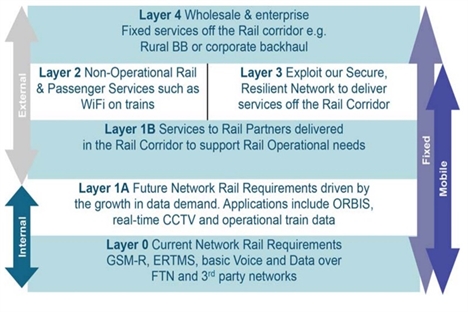11.04.14
Network Rail to roll out wireless FTNx network in six months
Network Rail is to go live with its new FTNx wireless network in six months’ time, enabling it to monitor ‘millions’ of sensors and devices across the UK’s railway infrastructure.
Craig Ellis, Network Rail Telecoms head of technology, told the audience at yesterday’s Cisco’s ‘IoE: Bringing the Future to Life’ event in London that real-time monitoring via sensors will improve service reliability and performance on the country’s railways.
He also stated that the new network will offer a “significant” increase in bandwidth availability through the use of optical broadband and IP technology. Additionally, the upgrade will allow CCTV, infrastructure sensors and consumer devices to be connected.
Ellis said, that the ability to link consumer devices could also improve safety for Network Rail staff, passengers and pedestrians. For example, wearable technology could be deployed to alert rail workers to an oncoming train.
“We already have a very sophisticated lookout warning system. However, with IoT a wearable patch or bracelet could form the last method of protection warning people that a train is coming down the track,” Ellis told Computer World UK.
He also noted that managing security of all of these endpoints has required a change in security strategy. But he believes that a “closed network” presents more risk than an “open network” which can be controlled more effectively.
In Network Rail's Strategic Business Plan for CP5, it explained the project like this:
Network Rail Telecom (NRT) owns and manages the national telecoms assets of Network Rail. Unlike the devolved route assets, telecoms assets are managed nationally as a single coherent network. NRT is tasked with delivering the current and future operational telecoms requirements of the railway, driving efficiencies and delivering additional value from these assets by extending the offerings to rail partners and optionally third parties.
Our vision is provide carrier class services to Network Rail and the wider rail industry as data volumes grow and become increasingly mobile. Building on that base we’ll extend our CNI capable network externally to become a significant player in the UK communications.
Network Rail’s key strength is an extensive telecoms network trusted to run one of the most critical national infrastructures in the UK. NRT will extend this network with FTNx (a next generation network) and high speed mobile data and use these to consolidate the rail industries growing data requirements and remove dependencies on 3rd parties. Once the rail industry is fully served, consideration will be given to external fixed data services, exploiting our resilience and security.
NRT needs to deliver 4G mobile data services for future train operational needs, ORBIS trackside applications and passenger Wi-fi. Our strategy is to partner with one or more partners, using their spectrum and our physical masts and backhaul assets to build this network at least cost to Network Rail. This in turn will drive value added service provision and help meet strategic themes.
NRT currently delivers services via Layer 0 in the diagram below – Using the existing low capacity FTN network and 3rd party services from BT and Level 3 to run the railway. Layer 1A is the first step in extending the network to support future rail operational needs.
FTNx – a new high speed network overlaid on FTN – will support data hungry services (SCADA, TM, ROCs, Corporate Voice and DATA) and high definition CCTV while allowing NRT to migrate from 3rd party suppliers and bring down provision costs.
Using FTNx, layer 1B services will be extended to the rail family along the rail corridor – connecting TOC stations, depots and switching centres to more efficiently run the railway. Consideration will be given to full utilise strategic partnerships Layers 2 and 3 will extend FTNx and mobile services beyond the rail corridor to run our rail family corporate functions and have potential to support CNI networks such as the British Transport Police. Finally, Layer 4 services will be considered proving traditional wholesale and enterprise data services and supporting UK PLC through rural broadband initiatives etc.

Tell us what you think – have your say below or email [email protected]